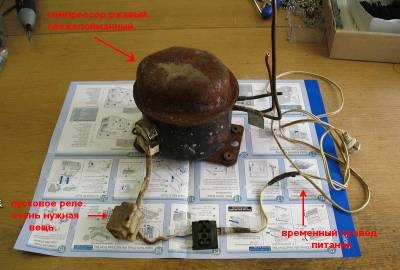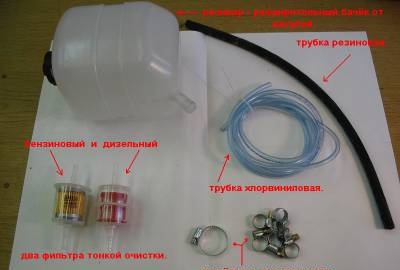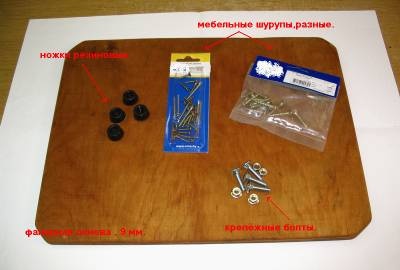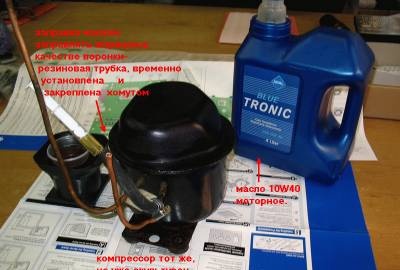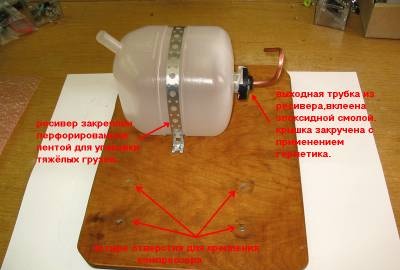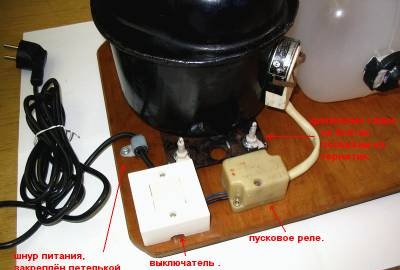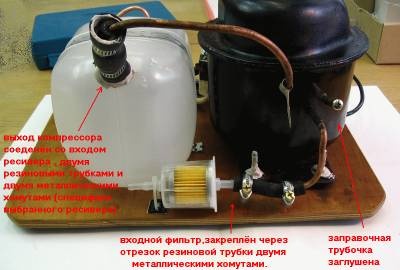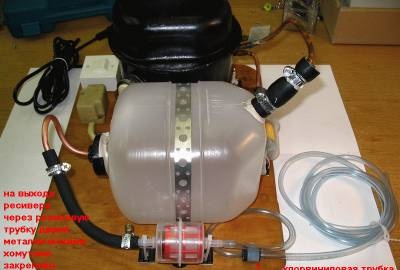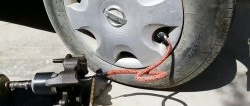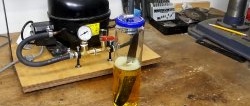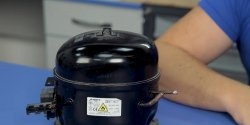article about using an old compressor from a refrigerator for use in an airbrush.
So chapter one: production.
Typically, in our latitudes, the habitat of wild or feral compressors is quite small, although exceptions do occur. Most often they can be found near trash cans in the courtyards of houses or in basements where all kinds of rubbish are stored. Usually they are tightly screwed to a large white box, which is popularly called a refrigerator, and beer is stored in it. You won’t be able to hunt a wild compressor with your bare hands; it won’t just be given to you. In the meantime, while you are running for weapons, the wild compressor may well become domestic, but already alien.
You must have a special set of weapons with you - pliers, flat-head and cross-head screwdrivers, 2 12x14 wrenches. If you find a large white box, you need to carefully inspect it; usually the compressor is hidden in its lower part at the back. If the compressor is found and you have the necessary set of weapons, you can start mining.
Extracting a compressor is a simple process, but you need to approach it carefully and carefully, otherwise there may be problems later. The first thing to do is to use pliers or side cutters to bite off the copper tubes that go to the cooling grill, with an allowance of at least 10 cm, or better yet, to the maximum, then the extra tubes will come in handy (on some types of compressors, a metal plate with embossed numbers is attached to the tubes - don’t throw it away, it might come in handy too). Moreover, the tubes must be bitten off! Under no circumstances should you cut, the chips will definitely get inside, and then your compressor can get very sick and die. When bitten off, the tubes will flatten, you don’t have to worry about this, and it will also help you avoid getting covered in oil during transportation.
At this stage, I can recommend pouring a drop of oil from the compressor onto a piece of clean paper and checking it for the presence of metal particles. If specks of silver dust are noticed in the oil, you don’t have to continue any further and honor the blessed memory of the deceased unit with a minute of silence.
Second and most importantly, the compressor consists not only of hardware, it has another and very important organ - the start relay. The relay looks like a small black (sometimes white) box, separately screwed with screws next to the compressor, with wires going into and out of it. You need to carefully unscrew the relay from the refrigerator, and in the same way carefully disconnect the connector that goes from the relay to the compressor body (this applies to old pots; for other types of compressors, the relay may not be removable). The incoming 2 wires will most likely have to be cut off; they still do not go straight to the plug. There is one more important point - you need to remember or mark in what position the relay was screwed on, where is the top and bottom, it is sometimes signed, but not always.Why it’s important - more on that below.
And finally, thirdly, using 2 12mm wrenches, unscrew the compressor body from the refrigerator. It is usually fastened with 4 bolts and nuts through rubber gaskets. It is advisable to take this entire set of fasteners and rubber bands with you; it may be useful in subsequent preparations for work.
Chapter two: preparation (domestication).
So, you just got your compressor, smeared with dirt and oil, with your hands scratched and stretched to your knees, tired but happy, you finally made it to his house. Now you can begin preparing the compressor for operation. The first thing you need to do is a control launch. We connect the relay connector to the contacts in the compressor housing. We orient and temporarily fix the relay on a horizontal surface, you can even stick it with tape. The main thing is to secure the relay as it was in the refrigerator; it works on the basis of gravity and heating of the plates. If you orient it incorrectly, or simply throw it in the air, it will not work correctly, and this can be fatal for both the relay and the compressor motor windings.
Carefully and using electrical tape, fasten a temporary wire with a plug to the wires entering the relay. I strongly recommend wrapping the twisting area with electrical tape, your safety and life depend on it. There are already few modellers, let’s value them and ourselves. The flattened tubes need to be crimped with pliers, they will move apart and free up the passage of air.
When everything is ready and secured, you can plug the plug into the socket. This is usually accompanied by a slight spark and pop, but the load is still considerable. If everything is in order, the compressor should turn on and rattle quietly. Air must come out of the tube, you need to mark which of them is “inhaling” and which is “exhaling”.There is no need to drive for a long time, the main thing is to make sure that the assembled unit is working properly. If it is not in order and the compressor does not start, or starts and turns off after a while, the situation is rather bad. For a small inspection you need to be familiar with electrical engineering and a tester. If you are not comfortable with these things, I do not recommend poking around further.
Well, if you are friends or have an idea, let’s continue. You need to remove the relay connector from the compressor and ring the motor windings. They should ring with little resistance to each other in any combination. If one of the windings does not ring, we are holding in our hands the body of a dead unit. If you call, it means you need to inspect and clean the relay. Carefully open the box and clean the contacts with fine sandpaper. The main thing is not to bend or break them; you also don’t need to rub them too hard.
Then we put everything back together, secure it as it should and try to turn it on again. If it doesn’t start again or turns off - alas, no luck... (This is provided that the relay is original and came with this compressor. Emergency shutdown can also occur due to the fact that the motor is more powerful than the one for which the relay is designed, then you will have to look for another relay, and the sign on the handset will help with this.) However, let’s not talk about sad things, we hope that everything worked.
Now you have to assemble your unit into a more suitable and compact device. Of course, I do not claim to be the truth, everyone has their own capabilities and means to achieve this goal, but I will outline my approach to assembling the entire device. To do this, you need to visit the nearest auto parts store, car market or spare parts stall. There you need to buy:
A liter of engine oil for replacement, 10w40 or other mineral or semi-synthetic.Usually a liter is the minimum container, but if you’re lucky, it comes on tap, even 500 grams is enough. At worst, you can lubricate all the squeaky hinges in the house.
A rubber reinforced oil and petrol resistant tube, about a meter long and 4mm in internal diameter. It’s a good idea to have a piece of copper tube from the compressor with you, you can try on the desired rubber tube to it.
Metal tie clamps, 6 pieces. They need to be tried on with a freshly purchased rubber tube. They should be a little larger in diameter.
Vinyl chloride tube for glass washer. They are translucent, there are also reinforced ones, but we don’t need those. The length must be chosen depending on the location of the compressor and the comfort of operation, but not less than 2 meters.
2 fine filters - one for gasoline, the second for diesel fuel. They are visually different - for gasoline there is a paper accordion inside, for diesel there is a synthetic mesh inside.
A tube of oil and gas resistant silicone sealant, thick consistency and gray color is better, more liquid and black is worse.
After purchasing all this, you need to head to the nearest hardware store. In it you must purchase:
A cord with a plug at the end for powering the compressor into the network. At least 1.5 meters long, preferably double insulated.
Single-key light switch in a closed type housing, for external installation.
Furniture wood screws 3.5 x 16 or 3x16.
Now this whole bunch needs to be combined together, and we will get the coveted unit.
The first and most important preparation point, on which the further operation and durability of the compressor depends, is changing the oil. Quite a few copies were broken in this regard, it is necessary to change, it is not necessary, which oil to pour and which not.
There may be many opinions, but the correct one is mine! So that later empty questions do not arise like “does it work well for me on sunflower!”, I will write down my point of view on this moment.
Pure “spindle” (freon, compressor - as it was not called) oil is poured inside the compressor at the factory. In fact, it is mineral. It does not contain any additives, because the compressor in the refrigerator operates in a closed and airless (oxygen-free) space, and is not exposed to any influence from the external environment. When we begin to use it for our purposes, the situation changes radically. The oil begins to be affected by air oxygen, dust microparticles, moisture, etc. Mineral oil quite quickly becomes clogged and oxidizes, losing its properties. This leads to strong heating of the compressor during operation, noise, wear of the piston system and, ultimately, jamming. And this despite the fact that there was enough oil. Moreover, due to the small binding and wetting properties of mineral oil, it will intensively fly to the outlet, clogging vapors of air and reducing the operating level in the compressor.
Automotive (motor) oil is devoid of most of these problems, primarily due to the fact that it contains a package of additives that compensate for or completely eliminate bad factors that affect the quality and durability of the oil. Moreover, it is designed for much more severe operating conditions than those that will be in your compressor. For example, I use motor semi-synthetic 10w40, because it remains after changing the oil in my car. You can use both mineral and semi-synthetic oil with other indexes, but I do not recommend using synthetic oils.Firstly, they are significantly more expensive, and secondly, they are more liquid and less durable.
I hope that I wrote convincingly, although of course there will be non-believers who will stubbornly pour any oil they can get their hands on, and, well, the flag for them.
Let's return to our iron friend. Here a certain technical point arises, namely, what type of compressor is in your hands. Visually, they are divided into 2 main types - a cylinder and a pot (resembles a night vase covered with a convex lid). The first are an almost extinct species; they were used in very old types of refrigerators and ceased to be produced in the late 70s. But if you managed to get this type of compressor alive, you are very lucky. They can give much higher output pressure than others. Most often, it is the second type of compressor that comes into our hands - pots.
The main difference for us at this stage is where to change the oil. In cylinders, most often a huge bolt is screwed into the side of the housing; it closes the filler neck. You need to unscrew it with a wrench, drain the old oil from the compressor into some disposable container. It is advisable to measure how much of this oil there was. Depending on the type of cylinder, they need to be filled with 300 to 500 grams of oil. Then carefully screw the bolt back, preferably covering it with oil and petrol resistant sealant.
The potty is a little more complicated. There are usually 3 tubes sticking out of it - inhalation, exhalation and a sealed filler tube. It is advisable to change the oil through it. To do this, we need to open this tube; we can cut it a little with a needle file in a circle below the flattened place, but under no circumstances cut through it. Then, along the cut, you need to break the tube and break it off completely, swinging it to the sides.The burr formed along the edge must be lightly beaten with a hammer. Then simply drain the oil from the pot, tilting it towards the tubes, into any disposable container. Remember - after draining the oil, do not turn on the compressor under any circumstances!
You will have to fill the compressor with a syringe, gradually pouring oil into the filler tube; you can put on a rubber tube in the form of an improvised funnel. About 250-350 grams of oil per pot are required. After refueling, the tube must be plugged, otherwise the air will escape through it (or vice versa - enter past the filter, depending on the type of compressor). You can, of course, flatten it, but this is not convenient, because then the oil will have to be changed. I recommend screwing in a small self-tapping screw of a suitable diameter, under the head of which there will be a rubber washer-spacer.
As in the case of oil, there will be desperate or lazy comrades who will try to feed the compressor with oil on the go, adding it to the suction tube - I strongly do not recommend doing this. Firstly, it is advisable to change the oil all at once, but turning on the compressor with drained oil means killing it. Secondly, there is such a phenomenon in piston devices - water hammer. This is when liquid enters the space above the piston in a volume greater than the volume of the compression chamber allows. Liquids, as we know, are almost not compressed, but the compressor motor will try to do this. As a result, we may experience destruction of the piston system. I hope that I have convinced you of this too.
And so we will continue. Now we will put everything in a heap, according to the given diagram.
This scheme is intended for single-action airbrushes, such as our beloved “Eton” - aka Belarusian, or double-action airbrushes converted to single action.
You can, of course, connect it all and leave it hanging, but this structure will constantly break and fall apart. I think if you spend a little effort and combine everything on some platform or in a case, it will be more reliable and give you more pleasure from work. I don’t pretend to standardize, but my type of assembly absolutely does not require the use of machines, welding or special tools. All materials are also available and their cost is low. For the simplest and most reliable result, you can assemble the structure on a sheet of plywood or chipboard. The dimensions of this sheet mainly depend on the type of receiver selected or obtained. The receiver is needed for at least two functions - it smoothes out air pressure pulsations that are inevitable during compressor operation, and serves as a vapor and oil droplet trap. For inexpensive single-action airbrushes, which include the widely used "Eton" - also known as Belarusian - a large-capacity receiver is completely unnecessary; a volume of about 1-2 liters is sufficient.
As practice shows, almost any hermetically sealed container is used as a receiver - from plastic bottles for drinks and beer to industrial receivers from trucks and equipment. In my opinion, using plastic bottles, and even more so glass, is somewhat unsafe; these materials do not have good mechanical strength, and even slight pressure in the receiver can rupture it if damaged and cause injury.You can, of course, use such things as a fire extinguisher cylinder, but this somewhat enlarges and makes the entire structure heavier.
The most optimal containers for the receiver are small food cans for water made of translucent white polyethylene, or, as in my example, an expansion tank from a Lada car. The polyethylene from which these containers are made is quite thick and viscous, is not afraid of mechanical damage from falling small objects and retains its properties for quite a long time. Even if a rupture occurs, it does not produce fragments or scraps of material. For those who do not want to use such materials under pressure, I can advise you to take a closer look at small welded metal fuel cans with a volume of 5 liters.
Adapting a canister or tank for a receiver is quite simple - you need to take 2 tubes, for example copper ones, cut from a compressor, each about 15 cm long. Don’t forget, there must be tubes at least 10 cm long on the compressor. 2 holes are drilled in the lid of the canister into which these tubes should fit tightly. Then, from the inside of the lid, the place where the tubes enter is filled with epoxy resin; there is no need to fill it completely, you need to leave some more space for screwing in the neck. When everything dries, you need to lubricate the neck and plug with sealant and screw it tightly. At this point, it is important to place the tubes correctly - their tips should not be next to each other, and the outgoing tube should be higher than the incoming one (as in the diagram).
Now that everything is prepared, you can figure out what size sheet of plywood is needed. You shouldn’t assemble it tightly, as it will be more difficult to maintain, and the compressor should have some space around it for air flow and cooling.In my case, a piece of 30x40 cm was enough. Plywood should be at least 9 mm thick, a fiberboard sheet - 15 mm. Trimming the corners and processing with coarse sandpaper is already a taste. But splinters in the fingers will not bring pleasure.
At the corners of the sheet on its future lower part, it is necessary to secure the legs, rubber or, for example, caps from plastic bottles with screws (a good reason to take 4 “one and a half” beer). The main thing is not to screw it all the way through to the floor or table. The legs are necessary to reduce noise when the compressor is operating, prevent it from “creeping” from its place, and scratching the floor is also unpleasant.
Next, 4 holes are drilled for the compressor mounts; I hope you didn’t forget to take the bolts with you? It is possible that when using a thick sheet of plywood or chipboard, the length of the standard bolts may not be enough, then you will have to buy longer ones complete with nuts at a hardware or auto store.
The most difficult thing is to secure the receiver. It must be installed first so that other parts of the unit do not interfere later. There is no need to pierce the receiver right through with fasteners; a creative approach is needed here - for example, use a rubber tube or strip, durable fabric or leather, perforated tape for packing heavy loads, etc. One edge of the fastening tape is screwed to the plywood with a screw, thrown over the receiver and tightly screwed onto the other side.
The compressor is secured with bolts, preferably with tubes, to the edge of a sheet of plywood, this will make it easier to change the oil in the future. When screwing, it is advisable to lubricate the threads of the bolts with sealant, so they will not subsequently unscrew due to vibrations. We screw the starting relay next to it with screws, orienting it correctly. Next is the light switch; we connect a relay and a power cord to its contacts.It is advisable to secure the cord itself with a tie or loop to a sheet of plywood, so it will not break out of the switch.
When the electrical part is finished, we proceed to install the rest of the pneumatic system. At the compressor inlet, using a piece of rubber tube and 2 clamps, we attach a fine filter for gasoline. Perhaps this part may seem unnecessary to someone, but it is not expensive, and all sorts of dust will not get inside the compressor, then it will not be possible to remove it from there. The main thing during all subsequent operations is not to fill this filter with oil, as this will cause it to lose its properties. Next, use a piece of rubber tube and 2 clamps to connect the compressor output to the receiver input. You must act carefully so as not to break the tubes from the lid. We also stretch a rubber tube with 2 clamps onto the outlet of the receiver and attach a filter for diesel fuel. This filter can be filled with silica gel, then it will perform 2 functions - a moisture trap and an adapter for securing rubber and vinyl chloride tubes. You can, of course, do without it, pull the vinyl chloride tube directly onto the outlet of the receiver, but such a connection will not be completely sealed and durable, the hose will break off from the smooth copper tube.
The vinyl chloride tube is usually smaller in diameter than the filter and airbrush fitting, does not stretch very well, and is quite difficult to fit. There is a little trick for this - the tip of the tube is immersed in solvent 647 for several minutes. It should not be deep, it should not be more than 5 mm, otherwise it will be too flexible and there will be no support for fitting it onto the fitting. It is advisable to secure the filter and vinyl chloride tube to a sheet of plywood, so it will not dangle and loosen the receiver tubes.
Well, that's practically all.You can turn it on and listen to the air hiss. Just don’t rush into work right away if you used silicone sealant - it needs to dry for a couple of days.
Chapter Three: Operation.
There is nothing complicated here. The main thing when operating a compressor is to prevent it from overheating. Typically the compressor heats up to a temperature of 40-45C in 25-30 minutes of continuous operation. It’s not worth working longer; this could have a negative impact on its resource and quality of work.
During further operation, you may have to adjust the air pressure. For example, some types of compressors can produce a much larger amount of air than is needed for an airbrush, or this is due to painting issues. In this case, the compressor will create excessively high pressure in the tubes, filters and receiver, and it itself will work with overload and heat up quickly. In this case, we need a gearbox. The most important thing is that the gearbox in this system must be installed at the INPUT of the compressor; if it is installed at the outlet, this will also cause overload of the compressor and its rapid heating.
By installing a reducer at the inlet, we limit the amount of air passing through the compressor, thereby regulating the pressure. The simplest and most accessible reducer is calibrated tubes, which can be attached to the filter inlet through a rubber tube, for example from pen refills, or thick needles from syringes. You can drill it yourself with different drills. Or you can visit the nearest pet store; in aquarium products you can find very suitable small taps and reducers. And according to the mounting diameters, they are just that, and they cost pennies. Unlike calibrated tubes, they will allow you to regulate the pressure within certain limits as you work.
Chapter Four: Maintenance.
Servicing the compressor is not difficult, although to do this you will have to partially remove some parts. Of course, you can not service the unit at all, but believe me, it will respond in kind.
The service includes:
Change of oil.
Replacing filters.
Drain accumulated oil from the receiver.
Oil, no matter how good it is, still loses its properties over time and becomes contaminated. In a compressor, regardless of the mode and amount of time it operates, it is advisable to change the oil at least once a year.
To do this, you need to remove all the tubes from it, unscrew the plug - screw - from the filling tube, and tilt the compressor, pour all the oil out of it. Remember - after this you cannot turn it on under any circumstances! Next, as with the first oil change, use a syringe to pour the required amount of oil inside. While the tubes are removed, you can at the same time remove the old filters and pour out the accumulated oil from the receiver. There is no point in pouring this oil back into the compressor.
Then install all the new filters in place and return the tubes to the compressor. Metal clamps help with this; they allow you to carry out similar operations repeatedly.
Well, that seems to be all, good luck. I think any additional questions that have arisen can be resolved on the forum.

